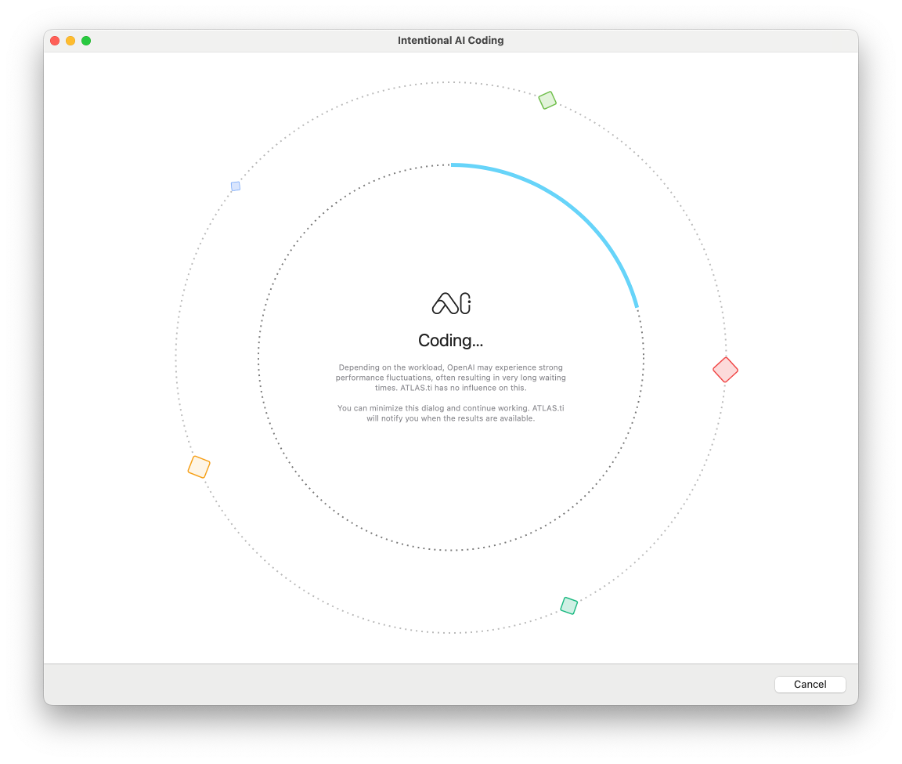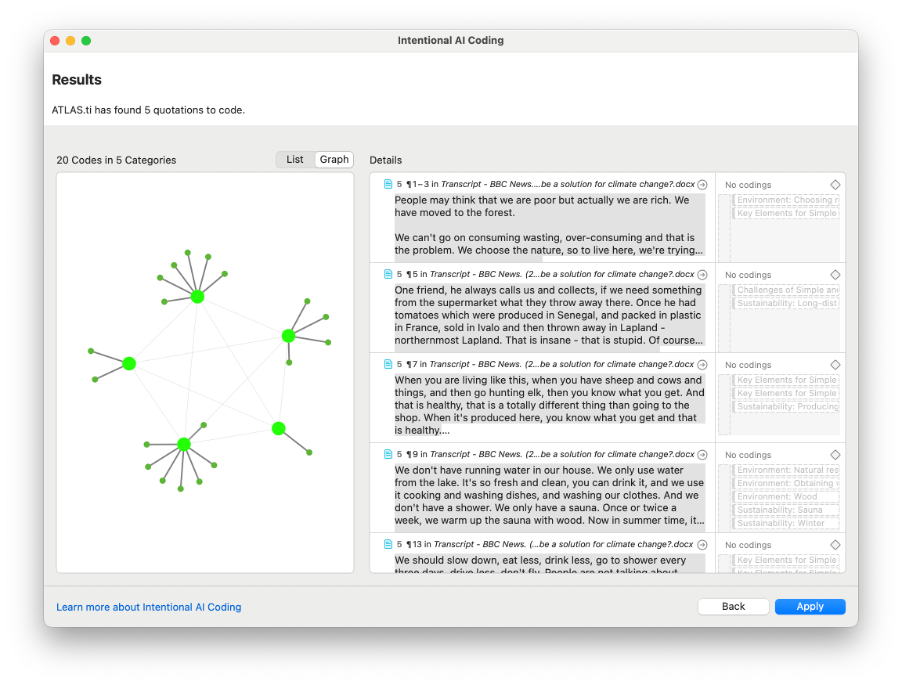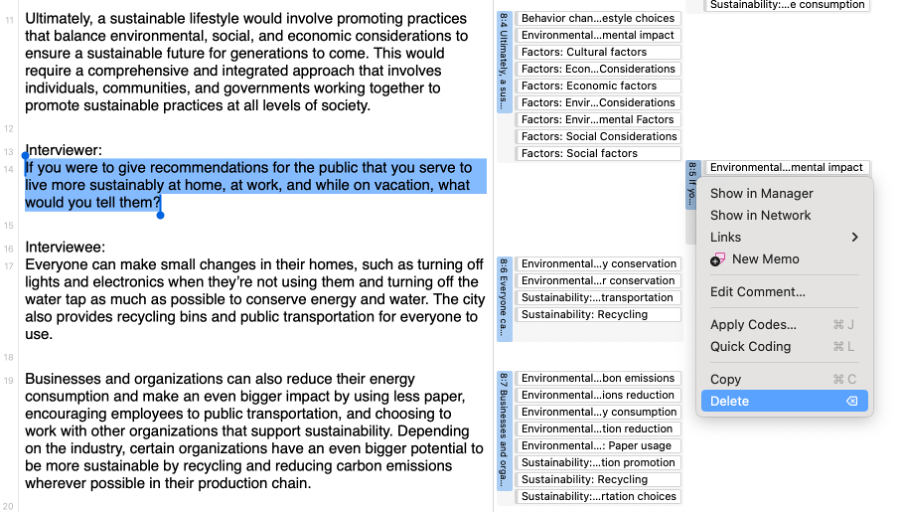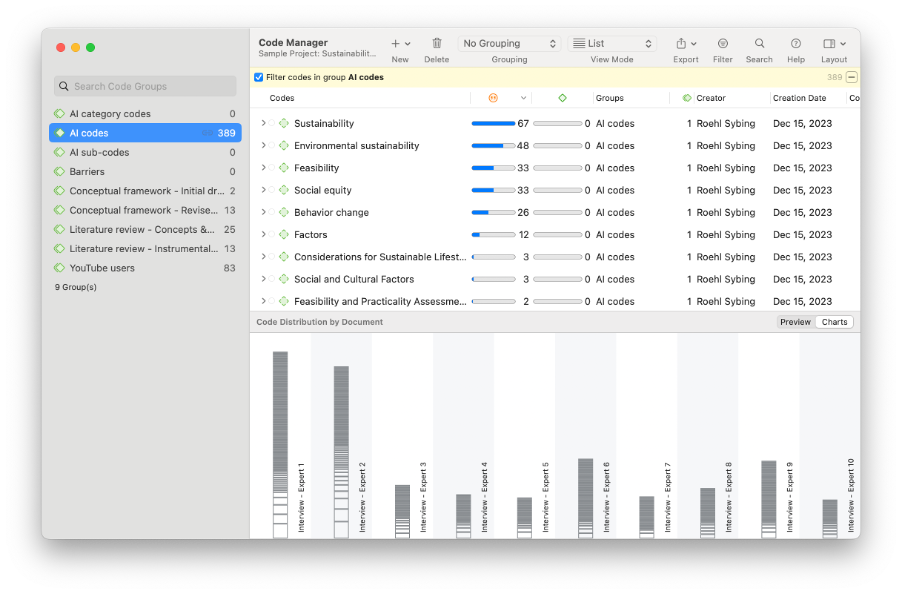Get the most relevant insights with Intentional AI Coding
- Introduction
- What does Intentional AI Coding do?
- Why do we need Intentional AI Coding?
- What is different from AI Coding?
- How do I use Intentional AI Coding?
- Considerations for using Intentional AI Coding
Introduction
Artificial intelligence has many potential applications for qualitative data analysis. With tools such as AI Coding, AI Suggested Codes, AI Summaries, and Conversational AI, users of ATLAS.ti can use artificial intelligence to understand and code their data quickly and efficiently, leaving time for more critical tasks involved in analyzing data. Now thanks to ATLAS.ti's AI Lab, the newest feature Intentional AI Coding can help you get to the point faster than ever before.
In this article, we'll look at Intentional AI Coding as a complement to our other AI-powered tools. Then we'll walk you through the process of Intentional AI Coding, from using it to code your data to conducting analysis on the generated codes.

What does Intentional AI Coding do?
You can use Intentional AI Coding to automatically code your data using OpenAI's large language models. The artificial intelligence powering Intentional AI Coding will read the data, generate codes, and apply the codes to the data.
More importantly, you can direct Intentional AI Coding to look for specific concepts or phenomena based on the research questions you give it. With the ability to take instructions from the researcher, Intentional AI Coding can tailor its coding approach to specific research inquiries and make the coding structure more amenable to the desired data analysis.
Why do we need Intentional AI Coding?
Intentional AI Coding allows you to employ artificial intelligence in automatically coding your data through a particular lens or perspective. This is useful when you recognize that people look at the world in different ways depending on their background, their knowledge, and their intentions.
Imagine a study of a workplace environment that involves observations of a place of business. People are sitting at desks while working on their computers, talking on the phone or in person with their colleagues or managers. The data collected from such a study is usually manifest in field notes and transcripts of any audio or video captured in the workplace environment.
Many kinds of people would be interested in analyzing the observation data. A boss might want to know what motivates their workers and increases their productivity. Someone who is interested in mental health might look at the data to identify signs of stress among employees. A communications researcher may be interested in how people in the workplace talk with each other to identify signs of agreement or disagreement.
In principle, any number of research inquiries can be addressed through analysis of this data. As a result, the codes that a researcher might apply to the data will depend on what they are looking for.
What is different from AI Coding?
AI Coding is great for broadly coding large sets of data automatically. Using OpenAI's GPT models, AI Coding looks at the meaning of words and phrases in textual data and applies labels that summarize the general meaning of the text. This is useful when you are conducting an inductive or grounded theory analysis of your data, or when you are still developing a sense of the meaning of the text. AI Coding can also help you identify concepts that you may not have considered when looking at the text, as it looks at the data as broadly as possible.
With Intentional AI Coding, on the other hand, you can tell ATLAS.ti about your research question to guide the automatic analysis. If you have a clear research question or know what you are looking for in your data, Intentional AI Coding can be a great fit for your data analysis. For example, if you are analyzing a specific aspect of a concept or phenomenon (e.g., productivity, stress, agreement), Intentional AI Coding can focus on coding only what is of interest to you.
Another consideration for the use of AI Coding is that it can produce many codes. This level of fine-grained detail is ideal for grounded theory research and inductive inquiries because you can group discrete codes into broader categories and themes that can contribute to your theory development. On the other hand, it can potentially give you codes that may not align with your research questions. Intentional AI Coding's narrower view of the data can provide you with the most relevant codes that are specifically tailored to your research agenda.
How do I use Intentional AI Coding?
Intentional AI Coding works with all text documents in ATLAS.ti, such as transcripts of interviews or focus groups, field notes from observations, or text from web pages or news articles.
To start, simply open Intentional AI Coding either from the Search & Code tab in ATLAS.ti Windows or the Analysis menu in ATLAS.ti Mac. You can then select all the text documents you would like the AI to code.
After you have selected which documents the AI should code, the Intentional AI Coding dialog box then provides you with a space to input your "intention." This is where you can tell the AI all about your research, such as your research question, analytic approach, research goals, the context of your data, or any other relevant details. This additional context is crucial for the AI to produce the best results possible. You can also choose from the list of previous intentions if they suit your inquiry.

Intentional AI Coding will then process your inquiry and suggest related questions relevant to your research. This is where you can further guide how the AI should analyze your data. Each question represents a key aspect of your research intention that the AI will search for, and any data segments relevant to each question will be coded with the category shown next to that question. These code categories represent the main topic or essence of each question, and each code category will contain relevant sub-codes generated by Intentional AI Coding. You can make any changes you’d like to the questions and code categories, including removing or adding questions.

Once you are ready, you can click on "Start Coding," and the AI will process your data using OpenAI's GPT models. Your data is always secure in ATLAS.ti’s tools and it will never be used by OpenAI for model training. You can always find more information about your data privacy here.
The more data you choose to process with Intentional AI Coding, the more time it will take to code. During the processing time, you can always minimize this window and work on other data analysis tasks in ATLAS.ti while Intentional AI Coding runs in the background.

When Intentional AI Coding is finished, you will be shown the Results screen which lists the identified quotations and suggested codes to apply to each quotation. On the left side, you can see a list of all the codes that Intentional AI Coding has generated, and these are hierarchically organized by their code categories. You can also view these codes as a visual graph grouped by the code categories. This is a good opportunity to review the quotations and add any additional codes you feel might be useful to apply to your data.

Once you have finished your review and clicked “Apply”, the Summary screen will display a report of the most frequently used codes and co-occurrences (i.e., codes that appear together). You can use this report to explore the results and gain initial insights. For example, what themes stand out to you? Or which codes were used together most often?

By the end of this process, your documents will be coded with specifically tailored categories and sub-codes so you can review and continue working with them. Depending on your research inquiry and your analytical approach, Intentional AI Coding may code a great deal of data or apply many codes. Now is a good time to look at your data and remove any quotations that may not be relevant to your research or adjust any codings (e.g., by merging codes, renaming codes, etc.).

Finally, you can see all the generated categories and their respective sub-codes in the Code Manager, where you can sort codes by their groundedness to get a sense of the prevailing themes in your data. You can also view only the codes created by the AI by clicking on the code group “AI codes” from the left-hand panel. This code group is automatically generated when you use AI Coding or Intentional AI Coding. The use of this code group as a filter can help you narrow down which codes were created by you or by artificial intelligence, in case you want to only focus on AI-generated codes or ignore them entirely.

Considerations for using Intentional AI Coding
Intentional AI Coding has the potential to accelerate your research through coding. That said, remember that it is a tool that can facilitate your efforts in data analysis, not replace them. With that in mind, let's briefly discuss some of the things you should consider when using Intentional AI Coding.
- Use multiple documents with Intentional AI Coding. Just like with humans, artificial intelligence relies on context in order to understand the information it is given. As a result, the more information it has to work with, the better. A larger dataset allows the AI to identify recurring themes and avoid duplicating codes. You might find the generated categories and their sub-codes more useful if you process multiple documents with Intentional AI Coding.
- Ensure your data is relevant. Intentional AI Coding relies on the data you give it being relevant to the research questions you are asking. For example, if your research question relates to medical advice, transcripts of interactions between doctors and their patients are bound to be more useful than a series of blog articles on financial planning. Be sure to carefully curate your data before processing it in Intentional AI Coding to get the best results.
- Review the results of Intentional AI Coding. The human researcher should always be the most important part of any qualitative research study, and the AI-powered tools in ATLAS.ti serve as dutiful "virtual assistants”. ATLAS.ti designs its tools to ensure that the researcher has the last word in reviewing and applying codes that are generated by artificial intelligence. Make sure the codings are relevant to your research question and context before using them in your analysis.
- Reorganize codes in the Code Manager. Intentional AI Coding produces new codes, so it is important to review those codes and how they compare to any existing codes you already have in your project. In the Code Manager, you can merge codes together and organize them into larger categories which can be used as additional units of analysis. Remember, you can always see which codes are generated by AI by clicking on the "AI codes" code group in the Code Manager.


